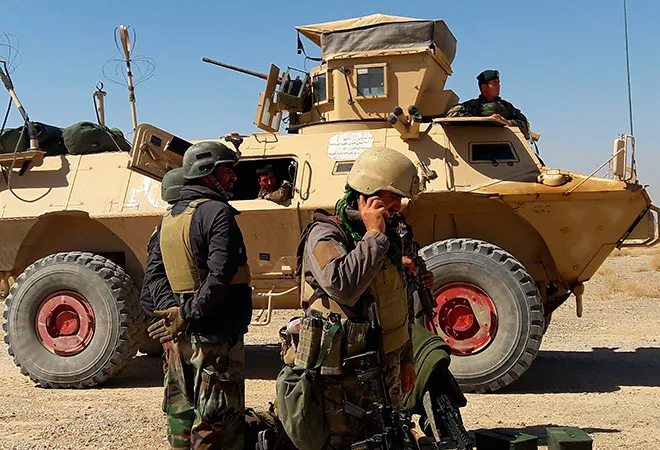
As the US troops begin withdrawal from Afghanistan, there remain various vulnerable groups that face an immediate threat from the Taliban. Firstly, women and young girls, because the Taliban’s ideology towards women remains regressive, orthodox, and downright extremist. This apprehension has been adequately validated recently with the Taliban having targetted women in the media, female judges, and even schoolgirls. Secondly, the human rights of various ethnic groups such as the Shia Hazaras, Ismaili Shias, Hindus and Sikhs remain in question and need to be protected. These communities have been historically persecuted and dominated by the Sunni majorities and according to the 2020 International Religious Freedom Report, terrorist groups in Afghanistan continue to target specific religious and ethno-religious minorities. Recent attacks in March 2021 by Islamic militants claimed the lives of seven factory workers from the Hazara community. In March 2020, a major attack occurred when an Islamic militant stormed a Sikh religious complex in Kabul leaving 25 worshippers dead and eight wounded, prompting a US Congress resolution supporting refugee protection for Sikhs and Hindus in Afghanistan from systematic religious persecution.
Recognising the urgency to protect vulnerable groups in Afghanistan, Senators Dianne Feinstein and Senator Joni Ernst have introduced a bipartisan “Protect Women’s and Girls’ Rights in Afghanistan Act” on 14 May 2021. The legislation promulgates that economic aid will not be provided to the Afghan government if minimum standards of treatment for women and girls are not met, mandating a bi-yearly assessment of how women and girls are treated, and monitoring the Taliban’s actions to secure the rights of women and girls.
Apart from the US drafting legislation to protect human rights, international allies of Afghanistan have been working to collaborate in their efforts to protect human rights. At an international donor conference in November 2020, representatives from 70 countries, including Germany, (US $510 million), Norway (US $72 million), the United Kingdom (US $227 million), and a number of humanitarian organisations pledged conditional aid of US $12 billion over the next four years, emphasising the importance that Western nations have placed on the protection of human rights. The Afghan economy’s overwhelming dependence on aid has made this approach an easy method for donor countries to do more for human rights in Afghanistan. However, such conditional aid could prove to be more dangerous by exacerbating poverty and worsening the deteriorating security situation. and make no impact on the current and future government (should it be a power-sharing government with the Taliban) to continuously strive to uphold human rights.
The Afghan economy’s overwhelming dependence on aid has made this approach an easy method for donor countries to do more for human rights in Afghanistan. However, such conditional aid could prove to be more dangerous by exacerbating poverty and worsening the deteriorating security situation and make no impact on the current and future government (should it be a power-sharing government with the Taliban) to continuously strive to uphold human rights
Growing global concern
The Taliban’s actions are concerning to the international community, that is growing increasingly anxious regarding the future of human rights in the war-torn country. Despite the militant group’s promise to reduce violence following the February 2020 US-Taliban agreement in Doha, more than 3,000 civilians were killed and 5,800 others were injured in Afghanistan in 2020. A string of attacks have continued in 2021 too, the latest of them being on June 2 when bombings on two transport buses killed 12 and wounded 10 in Kabul, with at least 90 casualties in the first five days of June itself. A report by the UN monitoring team recently concluded that the Taliban and the Al-Qaeda remain closely aligned and show no indication of breaking ties, which is contradictory to the promises the group made under the Doha agreement. The Taliban delegation also refused to show up for the Istanbul talks amid escalating violence, highlighting its disregard for a peaceful political settlement.
The US and other NATO powers are understandably eager to utilise their economic leverage to ensure a stable future, devoid of excesses in human rights violations. However, the billions of dollars sent to restructure the devastated economy since the fall of the Taliban regime has meant that the Afghan economy is heavily characterised by civil aid dependence to sustain its most basic services. Notably, the country’s US $11 billion public expenditure each year is much higher than its modest revenues, which even after significant improvements recently, barely reach even US $2.5 billion. The difference of about 75 percent of the expenses is funded by international grants. When aid has been cut off in the past, it has been detrimental to the lives of Afghans. In 2013/14, when the US reduced civil aid, there was a three percent increase in the overall poverty rate, the unemployment rate for Afghan men tripled and 76 percent of the rural jobs that were created in 2007/2008 were lost. The number of people living below poverty line grew from 38.3 percent in 2012 to 55 percent in 2017, an increase of five million. This increase in poverty coincided with the gradual reduction in aid flows from around 100 percent of the GDP in 2009 to less than 42.9 of the GDP in 2020, which led to the contraction of the service sector, leading to an associated deterioration in employment and income. The service sector is crucial in Afghanistan because an annual growth averaging a robust 9.4 percent between 2003 and 2012 was mainly driven by a booming, aid-driven service sector. Despite other factors such as growing insurgency and political instability contributing to this slump, since the flow of aid started reducing, the Afghan economy grew only by a meagre 2.5 percent per annum between 2015-2020. Therefore, civilian aid is evidently instrumental to the normal functioning of Afghan lives and must continue unhindered after American withdrawal.
The service sector is crucial in Afghanistan because an annual growth averaging a robust 9.4 percent between 2003 and 2012 was mainly driven by a booming, aid-driven service sector. Despite other factors such as growing insurgency and political instability contributing to this slump, since the flow of aid started reducing, the Afghan economy grew only by a meagre 2.5 percent per annum between 2015-2020
Afghanistan is also substantially reliant on military aid for its security forces that are embroiled in an intensifying war with the Taliban. Compared to the low-income country average of around three percent of GDP, security expenditure in Afghanistan stood at around 28 percent of the GDP in 2019 and most of this expenditure comes from foreign assistance, especially from the US. The US Congress appropriated at least US $86.4 billion for Afghan security assistance between fiscal years 2002 and 2019. Additionally, around 57 percent of total US assistance has gone to the Afghan Security Forces Fund and the US military spends about US $36 billion annually (roughly US $100 million a day) in Afghanistan. The Afghan forces could also lose out on the single-most important military advantage of airpower when private contractors and the US troops leave. The security forces majorly rely on US-funded contractors to repair and maintain their dozens of fighter planes, cargo aircrafts, helicopters, etc. Over 18,000 contractors are due to depart soon along with a majority of the US military contingent. Thus, reduction in aid would be extremely detrimental to the already fragile security situation in Afghanistan because without on-ground US troops, an aid-dependent Afghan force with reduced capabilities, would be the only line of defence against the Taliban’s incessantly violent tactics.
A financially sound Taliban
The NATO has warned that the Taliban “has achieved or is close to achieving, financial and military independence”. In the fiscal year ending in March 2020, the Taliban brought in US $1.6 billion, according to Mullah Yaqoob, the son of the late Taliban leader Mullah Omar. The Taliban has a plethora of financial inlets, the most prominent of them being the opium trade, amounting to approximately US $416 million yearly. Mining of rare-earth minerals such as iron ore, marble, copper, gold, zinc, etc. lucratively earns the Taliban approximately US $400 million to US $464 million a year. The Taliban earns approximately US $160 million annually by extortions and taxing territories under its control. They also make around US $200 million from covert financial donations from charities and private trusts located in Persian Gulf countries, US $240 million net income from import and export of consumer goods, US $80 million per annum from real estate in Pakistan, Afghanistan, and lastly, the governments of Russia, Iran, Pakistan, and Saudi Arabia are all believed to bankroll the Taliban, with these funds amounting to about US $500 million. While this financial independence could make the Taliban impervious to any international economic pressure, a lot of their assets and leaders are tied up under economic sanctions. However, Taliban has requested the cancellation of United Nations sanctions in exchange for the US asking for a three to six-month extension for troop withdrawal, which could not take place before the pre-set deadline of 1 May 2021. Considering that these pre-existing economic sanctions have failed to deter the Taliban from violating human rights, it is unlikely that any kind of economic pressure by withholding US or NATO aid would make an impact. In fact, if the US obliges to the request, it would loosen the Taliban’s purse strings further and they would continue with violence. Resultantly, lives will continue to be at stake, necessitating the flow of international aid for the Afghan security forces to safeguard human rights.
Taliban’s prospects of gaining back power and their continued human rights transgressions warrants international pressure as has been appropriately identified by these Western countries. Yet, the effects of economic cutbacks possibly falling on aid-sustained Afghan lives leading to an inflammation in the pre-existing problems of acute poverty and unemployment, paired with the Taliban’s immunity to financial pressures and its recurrent tendencies to flout agreements, merit questioning of the efficacy of providing conditional aid.
The views expressed above belong to the author(s). ORF research and analyses now available on Telegram! Click here to access our curated content — blogs, longforms and interviews.




 PREV
PREV


